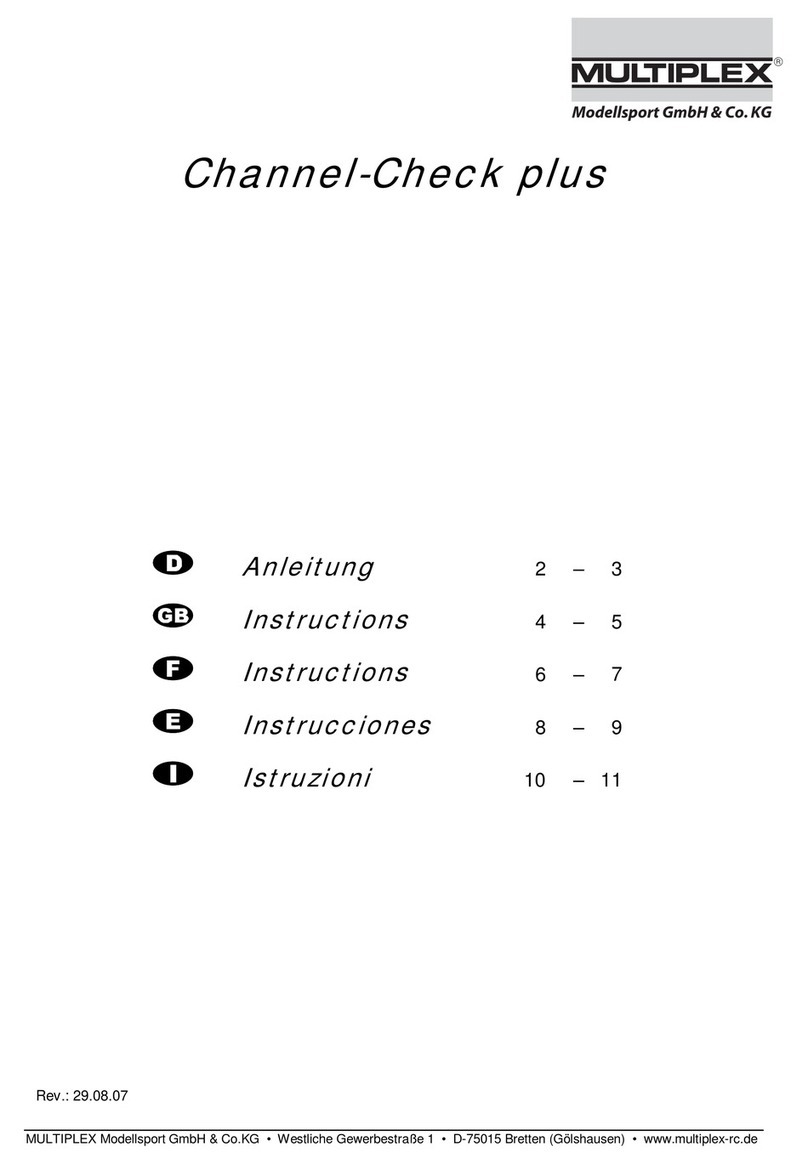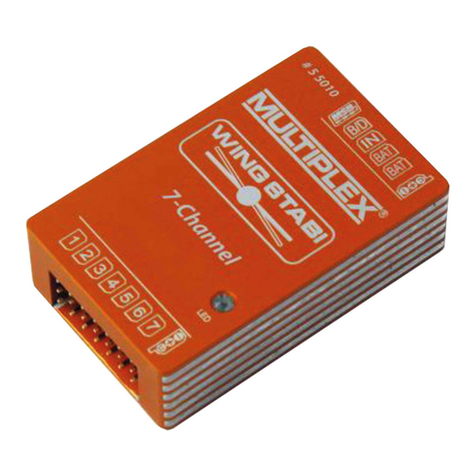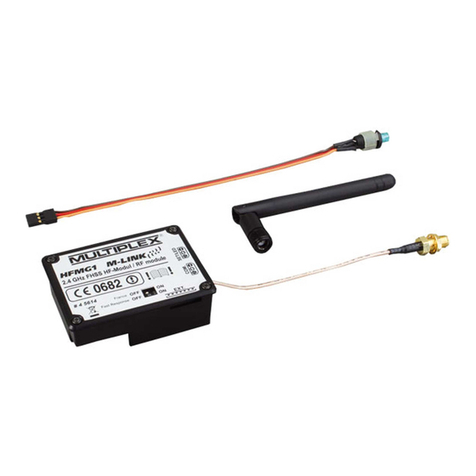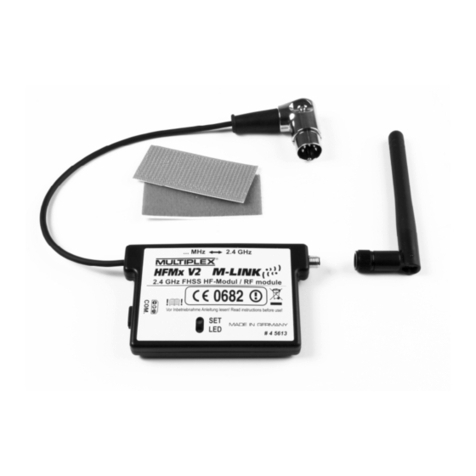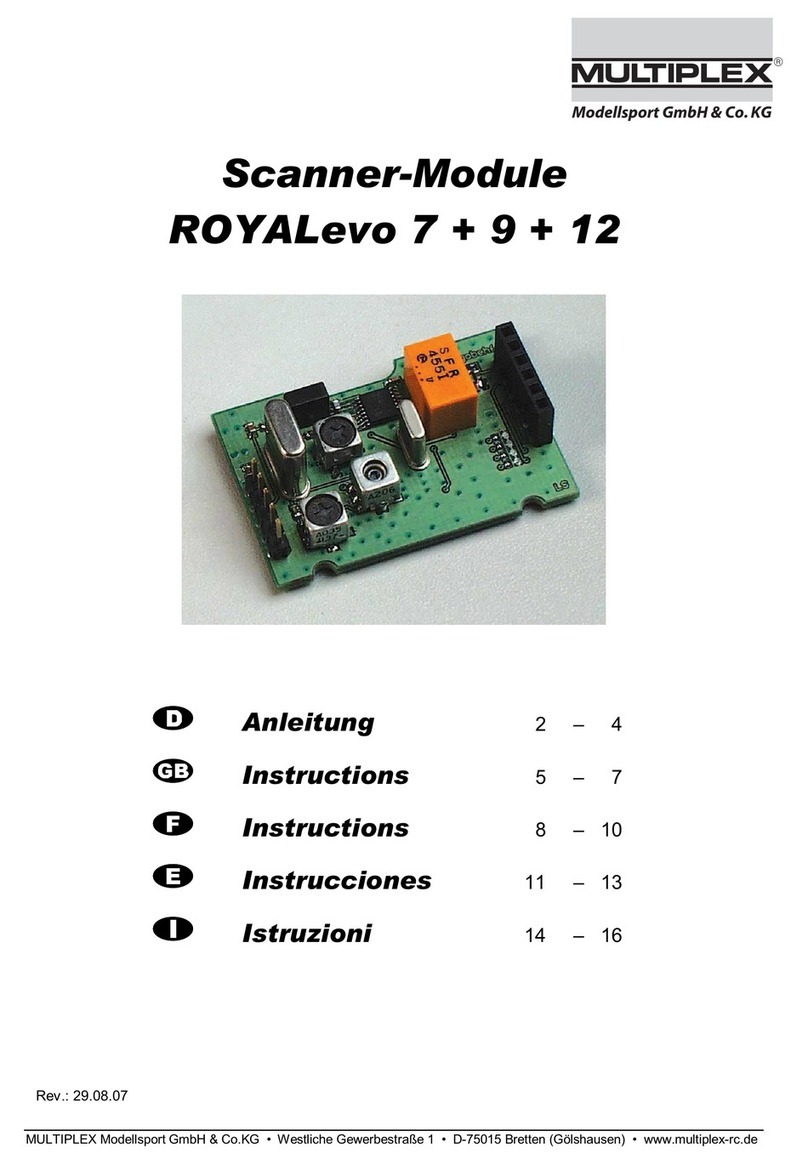
Bedienungsanleitung
2,4 GHz HF-Modul HFMx M-LINK
MULTIPLEX Modellsport GmbH & Co.KG • Westliche Gewerbestraße 1 • D-75015 Bretten (Gölshausen) • www.multiplex-rc.de Seite 1/6
nleitung 2,4 GHz HF-Modul HFMx M-LINK # 985 5341 (13-09-26/MIWA) • Irrtum und Änderung vorbehalten! •
MULTIPLEX
!Diese Bedienungsanleitung ist Bestandteil des
Produktes Sie beinhaltet wichtige Informationen
und Sicherheitshinweise Sie ist deshalb jederzeit
griffbereit aufzubewahren und beim Verkauf des
Produktes an Dritte weiterzugeben
1 TECHNISCHE DATEN
2,4 GHz HF-Modul HFMx M-LINK
Best.-Nr. # 4 5612
Frequenzbereich 2,4000 GHz … 2,4835 GHz
Eingeschränkter Frequenzbereich:
2,4000 GHz … 2,4540 GHz
Übertragungsart 2,4 GHz FHSS M-LINK System
Frequency Hopping Spread Spectrum
MULTIPLEX-LINK
Sendeleistung 100 mW EIRP
Stromaufnahme ca. 50 mA
Temperaturbereich
- 15°C … + 55°C
Abmessungen
(L x B x H) ca. 83 x 52 x 11 mm
(Gehäuse)
Gewicht ca. 65 g
2 SICHERHEITSHINWEISE
!Vor Inbetriebnahme Anleitung lesen.
!Nur für den vorgesehenen Einsatzbereich verwenden
(
3.).
!Keine technischen Veränderungen am HF-Modul vor-
nehmen.
Wenn Bauteile beschädigt sind, das HF-Modul bei einer
MULTIPLEX Servicestelle überprüfen lassen.
3 EINSATZBEREICH / KOMPATIBILITÄT
Das externe 2,4 GHz HF-Modul HFMx M-LINK ist ideal, wenn
Sie mit dem gleichen MULTIPLEX Sender häufig zwischen dem
35, 40, … MHz-Band und dem 2,4 GHz-Band wechseln, oder
einen älteren MULTIPLEX-Sender auch im 2,4 GHz-Band ein-
setzen möchten.
Das 2,4 GHz HF-Modul wird an die Lehrer / Schüler-Buchse des
Senders angesteckt und entweder direkt am Sender befestigt
oder am bzw. im Senderpult montiert. Es sind keinerlei Ände-
rungen am Sender notwendig.
Der nachfolgend verwendete Begriff „Lehrer / Schüler-Buchse“ steht für
die MULTIPLEX-Multifunktionsbuchse am Sender. Andere Begriffe hier-
für sind: DIN-Buchse, Ladebuchse, PC-Schnittstellen- bzw. Diagnose-
buchse.
Die Pluspunkte:
•Einfache und schnelle Umschaltung zwischen 35, 40, …
MHz (interner Sender) und 2,4 GHz M-LINK direkt am
2,4 GHz HF-Modul HFMx M-LINK über einen Schalter.
•Umschaltbar zwischen vollem Frequenzbereich und einge-
schränktem Frequenzbereich („Frankreich“-Mode“
4.).
•Umschaltbar zwischen 14 ms Servotaktzeit (Fast Response)
und 21 ms Servotaktzeit (
12.).
•Aktivierung von Binding-Modus (
8.) und Reichweitentest-
Modus (
11.) über die SET-Taste.
•LED-Statusanzeige.
Das 2,4 GHz HF-Modul HFMx M-LINK ist ausschließlich für den
Betrieb in folgenden MULTIPLEX-Sendern zugelassen:
•COCKPIT MM
•COCKPIT SX
•Combi 80 / sport / plus
•Combi 90
•Cockpit
•Commander
•Commander mc 2010 / 2015 / 2020
•EUROPA SPRINT
•EUROPA SPORT
•EUROPA mc 1005 / 1010 / 1020
•PiCOline
•PROFI mc 3010 / 3030 / 4000
•ROYAL mc
•ROYALevo 7, 9, 12
•ROYALpro 7, 9, 12
4 LANDESSPEZIFISCHE EINSCHRÄNKUNGEN
! Rechtlicher Hinweis: Sendegeräte dürfen nur auf den
Frequenzen /Sendekanälen eingestellt und betrieben wer-
den, die im jeweiligen Land zugelassen sind.
! Wichtig: Betrieb in bestimmten Ländern nur mit einge-
schränktem Frequenzbereich erlaubt!
In bestimmten Ländern ist der Betrieb von 2,4 GHz R/C-Sys-
temen mit 100 mW EIRP Ausgangsleistung nur in einem ein-
geschränkten Frequenzbereich erlaubt. Aus diesem Grund kann
das 2,4 GHz HF-Modul HFMx M-LINK wahlweise auch in einem
eingeschränkten Frequenzbereich betrieben werden (
13.).
Eine Übersicht über die betreffenden Länder finden Sie im Bei-
blatt „Betrieb des 2,4 GHz M-LINK Systems mit eingeschränk-
tem Frequenzbereich“.
5 DAS M-LINK ÜBERTRAGUNGSSYSTEM
M-LINK ist ein Übertragungssystem von MULTIPLEX. Es arbei-
tet auf dem 2,4 GHz ISM-Band und basiert auf einer modernen
FHSS Technologie (FHSS = Frequency Hopping Spread Spec-
trum).
Automatisches HF-Kanal-Management:
Eine manuelle HF-Kanalwahl (Wechselquarz, Synthesizer)
durch den Benutzer ist nicht mehr erforderlich. 2,4 GHz Spread
Spectrum Systeme teilen sich das Frequenzspektrum automa-
tisch. Es ist daher auch keine herkömmliche Frequenzüberwa-
chung nötig. Störungen durch Frequenzdoppelbelegungen (wie
im 35, 40, … MHz-Band möglich) sind praktisch ausgeschlos-
sen. Bei der ersten Inbetriebnahme des Systems müssen Sie
lediglich den Empfänger über eine einfache Binding-Prozedur
auf den Sender einlernen (Binding). Ab diesem Zeitpunkt verar-
beitet der Empfänger nur noch Signale Ihres eigenen Senders.
FHSS Technologie:
Im Abstand von wenigen Millisekunden springen Sender und
Empfänger im gleichen Rhythmus von Kanal zu Kanal. Während
eines Bruchteils dieser Zeit werden die Daten übertragen. Durch
die daraus resultierende kurze Kanal-Belegungszeit werden
Signalkonflikte minimiert und Störungen unterdrückt. Selbst
wenn Datenpakete auf einzelnen Kanälen verloren gehen, sind
durch das ständige, schnelle Springen auf den nächsten Kanal
Unterbrechungen für den Piloten nicht spürbar.
